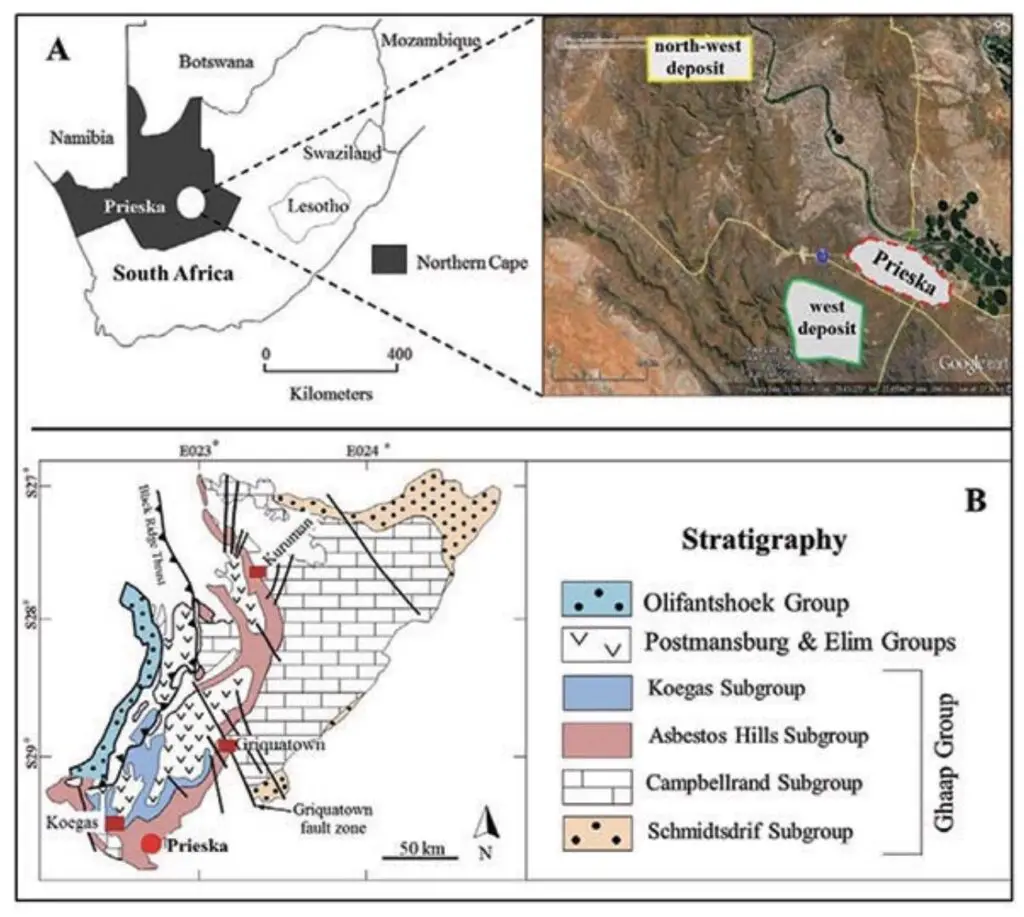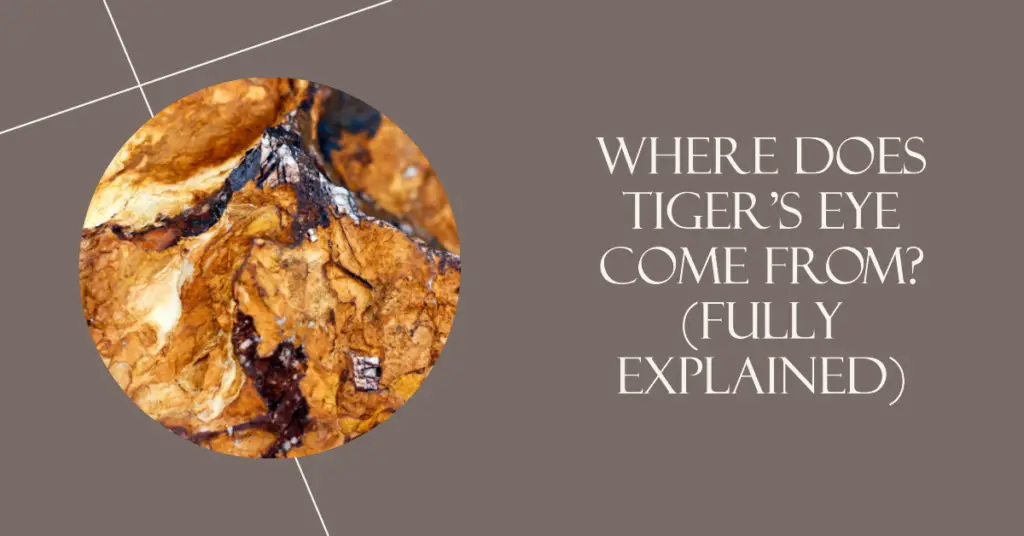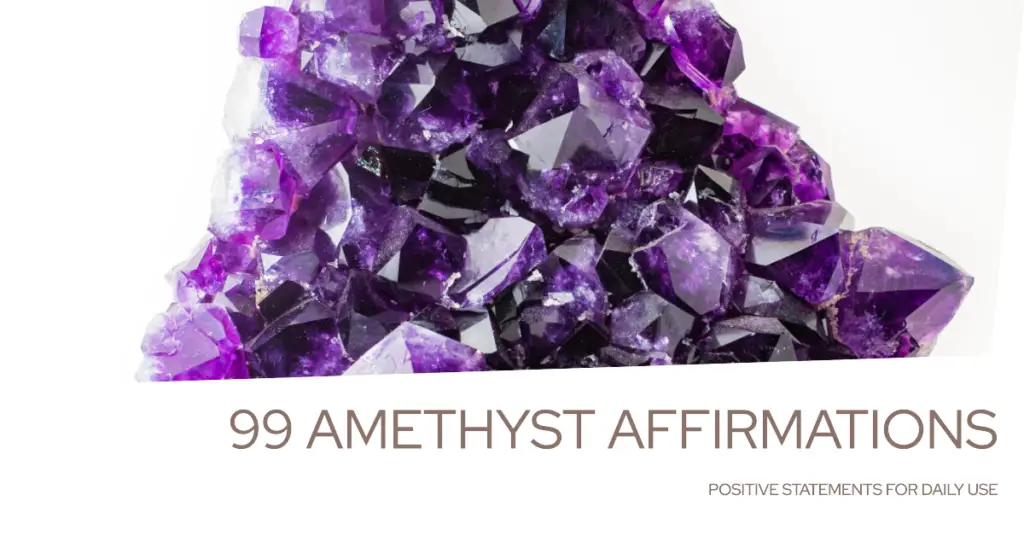South Africa produces over half of the world’s tiger’s eye. The tiger’s eye is also found in Australia, Burma, India, Namibia, the United States, Brazil, China, Mexico and Spain.
South Africa
South Africa’s tiger’s eye stone is mainly distributed in the Northern Cape Province, Niekershoop and Prieska area, up to the Keruman, extends to about 400km. in terms of its distribution of a large area, the mineralization of the general, most of them are exposed on the surface.
Most of them are small-scale manual mining, and few of them are mechanized. Due to the low level of exploration, the current resources and reserves are uncertain. The South African Department of Mineral Resources (DMR) has issued a total of 15 tigonite mining licenses in its history, all of which are on private farms. Prisca is the world’s largest supplier of tiger’s eye.
The Prieska deposits occur along the N10 highway route to Upington. Tiger’s eye forms in veins and lenses within banded iron formations (BIFs) of the Asbestos Hills Subgroup, part of the Transvaal Supergroup.

The banded iron formations were metamorphosed and underwent silica replacement, transforming the original iron minerals into fibrous asbestos. The asbestos was later replaced by quartz, while still retaining the fibrous structure, forming the chatoyant tiger’s eye.
Two major deposits were studied – one located to the west and another to the northwest of Prieska. The deposits contain zones of high and low grade tiger’s eye as well as fibrous crocidolite asbestos. The high grade zones contain mostly yellow tiger’s eye, while the low grade areas have more blue, variegated, and fibrous material.
Australia
Here, tiger’s eye is primarily found in Western Australia, in the rugged Hamersley Ranges of Pilbara.
This is an area extremely rich in iron ore and there are a number of large mines currently in operation.
Tiger’s eye has been found in small deposits across these iron formations, especially near Brockman Hill. This 6 mile long ridge has many small deposits that produce top notch tiger’s eye.
There’s a rare type of tiger’s eye that’s only found in Australia – Maramamba tiger’s eye. It occurs as isolated pockets within seams of blue crocidolite, often containing intricate and beautiful patterns of shiny metallic hematite, and is sought after by collectors for its rarity and value. It formed over 2 billion years ago when the Earth was still a barren place without life. Crazy!
United States of America
Tiger’s eye production in the United States is not large, but there are large quantities of tiger’s eye in several states, and serpentine deposits with chrysotile fibers have been found in Arizona and California. These stones have been cut and sold as “Arizona Tiger Eye” and “California Tiger Eye” stones.
China
Xichuan County is the most famous and the most important source of tiger’s eye stone in China, which was discovered in the 1960s and 1970s during the exploration of blue asbestos mine in Xichuan, Henan Province.
The Xichuan Tiger’s Eye Stone Mine is mainly located in the area of Foreshizhai, Xujiapo, Matoushan, and Chenjiagou in Xichuan, Henan Province, with a small amount in the southeastern part of Shangnan in Shaanxi Province, China, and in Utopia in Hubei Province.
Tiger’s eye stone produced in Xichuan is colorful, the most common are golden yellow and blue, in addition, there are yellow-brown, red-yellow, red, brown-red, purple-red, brown-red, yellow-blue, blue-gray, blue-green, even seven-color and other colors.

In most cases, the color of tiger’s eye stone is a variety of colors intertwined together, appearing with a strong contrast of light and dark changes in the strong silky luster, with the changes in the angle of incident light, the golden tiger’s eye stone sometimes seems to be like a flame jumping, flashy and attractive, the blue tiger’s eye stone is often presented is a kind of dark blue charming color. If the yellow and blue colors are intertwined, a vivid and fascinating phantom effect occurs.
Namibia
Produced in China Xichuan and Namibia’s ore belongs to a rare, special type, its composition of the mineral composition is more complex, dazzling pattern, and other origins of the ore has a clear difference. Internationally it’s known as pietersite.
The very high quality of Peter’s stone colorful, colorful patterns, so that people seem to enter the fantasy world, the flame-like red, bursting out of the golden light of the yellow, the deep sea-like blue, deep dreamy purple, together form a silky smooth ore.
Mexico
In Mexico, there is a higher quality tiger’s eye stone known as “Lightning Yellow Tiger’s Eye”. Lightning yellow tiger’s eye is mainly yellow gold in color, because of its cat’s eye effect of living light, color like a tiger’s eyes and so named. It is also known as the “Golden Tiger’s Eye”, a sacred stone that symbolizes wealth.
Lightning tiger’s eye stone has a fine and tough texture, with a micro-fibrous structure. If it is ground into a curved ring from the vertical fiber direction, a parallel moving “eye” will appear on the curved surface. It is named Lightning Tiger’s Eye because its shape and color resemble a tiger’s eye, and it has a sharp adamantine luster.

How does Tiger’s eye mined?
Mining Process
Tiger’s Eye is extracted through open pit and underground mining methods. The mining process begins with exploration to determine the location of potential deposits. Geologists analyze the physical and chemical properties of the rock to determine if it contains tiger’s eye.
In open pit mining, the overburden (the surface material covering the deposit) is removed, exposing the rock beneath. Open pits can be hundreds of feet deep and are typically used when the deposit is close to the surface. Once the surface is exposed, the rock containing the tiger’s eye is drilled, blasted, and loaded onto trucks for transportation to a processing plant.
Underground mining is used when the deposit is too deep to be mined through an open pit. In order to reach the tiger’s eye deposit, tunnels are dug underground. The rock is drilled and blasted in the tunnels and then transported to the surface for processing. Underground mining poses a greater safety risk than open pit mining due to tunnel collapse.
Processing
Once the rock is mined, it is transported to a processing plant. This material is crushed, screened, cleaned and sorted to separate the tiger’s eye from the waste rock. The coarse tiger’s eye rock is cut into blocks or chunks, depending on the final product.
At this stage, some tiger’s eye stones may be artificially enhanced. The stone is heated to improve its color and clarity. Once processing is complete, tiger’s eye stones are sorted by quality and then cut into final products, whether they are rough blocks, tumbled stones, cabochons, beads or other items.
About the Author
I was introduced to the power of crystals by chance during a trip overseas ten years ago, and began to learn about crystals and meditation. After years of experiencing firsthand the beauty and benefits of crystals, I founded CrystalWith to share my knowledge with others.




